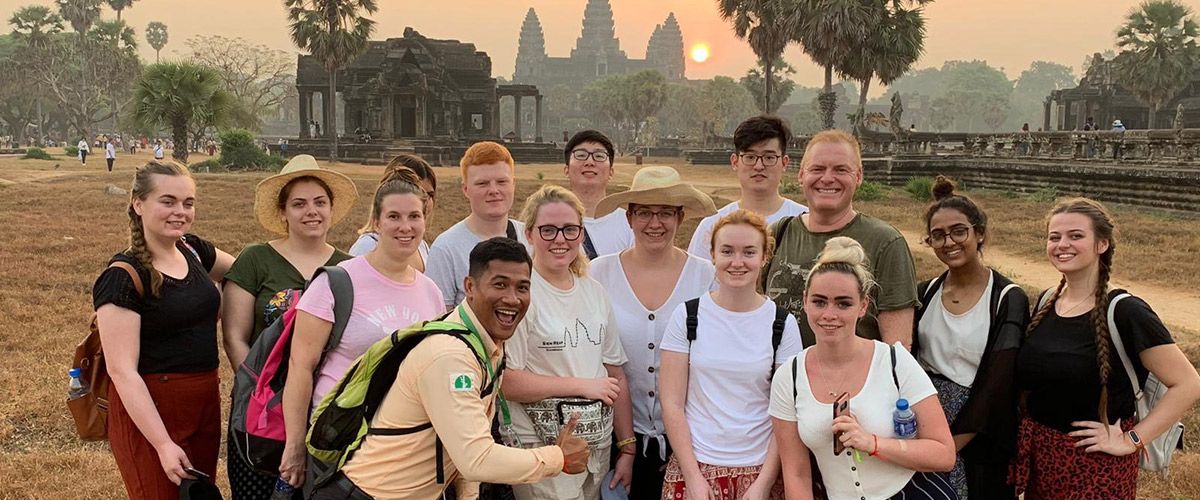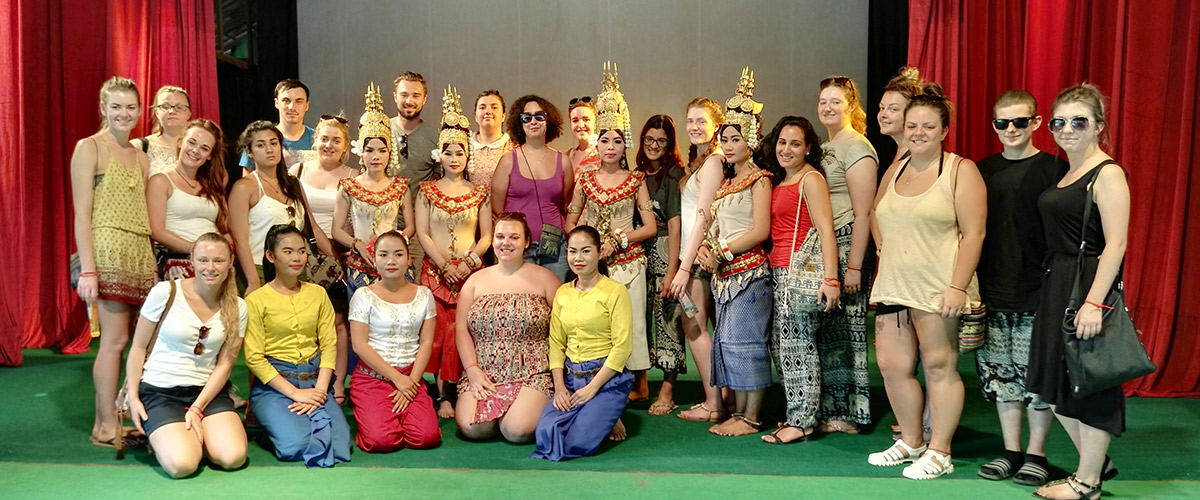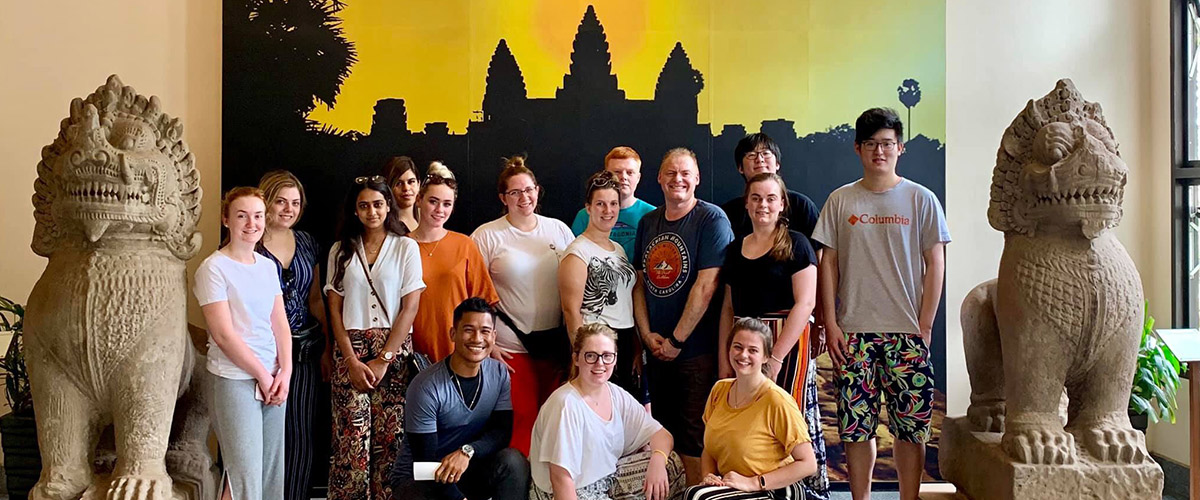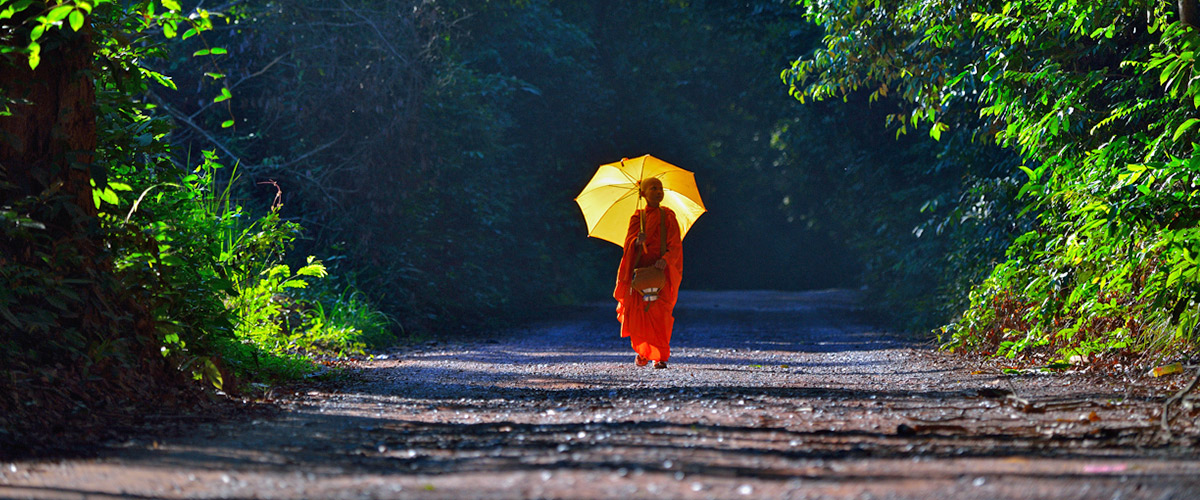Unique Activities
Siem Reap is the gateway to Angkor Wat, the ancient capitals of the Khmer Empire from 9th to the 15th century. Stretching over some 400 km2, including the famous temple of Angkor Wat, Angkor Thom, the Bayon temple, Preah Khan, Ta Prohm, examplars of Khmer architecture, religious and symbolic values, as well as containing high architectural, archaeological and artistic significance.
.jpg)
Angkor Wat Temple
It was built by the Khmer King Suryavarman II in the early 12th century in Yaśodharapura, the capital of the Khmer Empire, as his state temple and eventual mausoleum. Breaking from the Shaiva tradition of previous kings, Angkor Wat was instead dedicated to Vishnu. Angkor Wat, in its beauty and state of preservation, is unrivaled. Its mightiness and magnificence bespeak a pomp and a luxury surpassing that of a Pharaoh or a Shah Jahan, an impressiveness greater than that of the Pyramids, an artistic distinctiveness as fine as that of the Taj Mahal. Angkor Wat is located about six kilometers (four miles) north of Siem Reap, south of Angkor Thom. Entry and exit to Angkor Wat can only be access from its west gate.
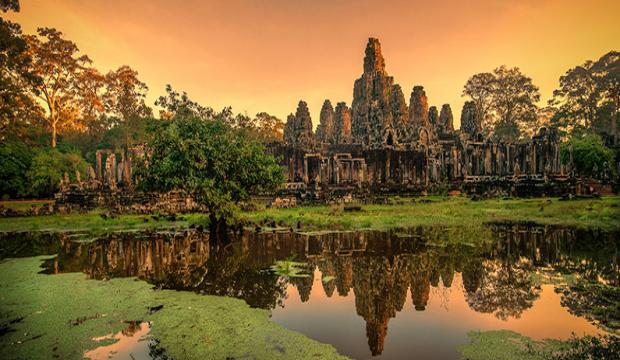
Bayon Temple
The Bayon is a well-known and richly decorated Khmer temple at Angkor in Cambodia. Built in the late 12th or early 13th century as the official state temple of the Mahayana Buddhist King Jayavarman VII. We stand before it stunned. It is like nothing else in the land. The Bayon is located in the center of the city of Angkor Thom 1500 meters (4921 feet) from the south gate. Enter tower of the Bayon is from the east. Over 216 large faces carved on the 54 towers give this temple its majestic character. It is generally accepted that four faces on each of the tower are images of the bodhisattva Avalokitesvara and that they signify the omnipresence of the king. The characteristics of this faces - a broad forehead, downcast eyes, wild nostrils, thick lips that curl upwards slightly at the ends-combine to reflect the famous 'Smile of Angkor'.

Ta Prohm Temple
Ta Prohm is the modern name of the temple at Angkor, Siem Reap Province, Cambodia, built in the Bayon style largely in the late 12th and early 13th centuries and originally called Rajavihara.
Shrouded in dense jungle the temple of Ta Prohm is ethereal in aspect and conjures up a romantic aura. Fig, banyan and kapok trees spread their gigantic roots over stones, probing walls and terraces apart, as their branches and leaves intertwine to form a roof over the structures. Trunks of trees twist amongst stone pillars. The strange, haunted charm of the place entwines itself about you as you go, as inescapably as the roots have wound themselves about the walls and towers', wrote a visitor 40 years ago.

Phnom Bakheng Sunset Hill
The construction of this temple mountain on Phnom Bakheng (Bakheng Hill), the first major temple to be constructed in the Angkor area, marked the move of the capital of the Khmer empire from Roluos to Angkor in the late 9th century AD. It served as King Yasovarman I's state-temple at the center of his new capital city Yasodharapura. The foundation of Bakheng is carved from the existing rock edifice rather than the laterite and earthfill of most other temples. Bakheng's hilltop location makes it the most popular sunset location in the area, offering a view of the Tonle Sap Lake and a distant Angkor Wat (upper right photo.) Quiet the rest of the day. Elephant rides up the hill are available for sunset. Always overcrowded at sunset, so much so that authorities are now limiting the number of visitors at sunset. Consider a alternative sunset location.
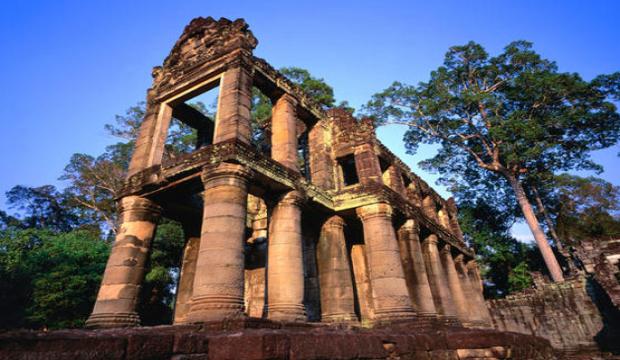
Preah Khan Temple
Preah Khan is a temple at Angkor, Cambodia, built in the 12th century for King Jayavarman VII to honor his father. It is located northeast of Angkor Thom and just west of the Jayatataka baray, with which it was associated. The inscription indicates that Preah Khan was built on the battle site where King Jaya-varman VII finally defeated the Chams. In those days it was known as Nagarajayacri which mean the city of Preah Khan. Four concentric ramparts subdivide Preah Khan. The outer or fourth wall, which is encircled by a wide moat, today encloses a large tract of jungle, formerly the living quarters of the monks, students and attendants of Preah Khan. The second rampart delineated the principle religious compound of about four hectares within which there is a dense concen¬tration of temple and shrines.

Banteay Srei Temple
Banteay Srei is the temple's modern name, Bantãy Srĕi citadel of the women, or citadel of beauty is probably related to the intricacy of the bas relief carvings found on the walls and the tiny dimensions of the buildings themselves. Some have speculated that it relates to the many devatas carved into the walls of the buildings is a 10th-century Cambodian temple dedicated to the Hindu god Shiva. Located in the area of Angkor in Cambodia. Banteay Srei is an exquisite miniature; a fairy palace in the heart of an immense and mysterious forest; the very thing that Grimm delighted to imagine, and that every child's heart has yearned after, but which mature years has sadly proved too lovely to be true. And here it is, in the Cambodian forest at Banteay Srei, carved not out of the stuff that dreams are made of, but of solid sandstone.
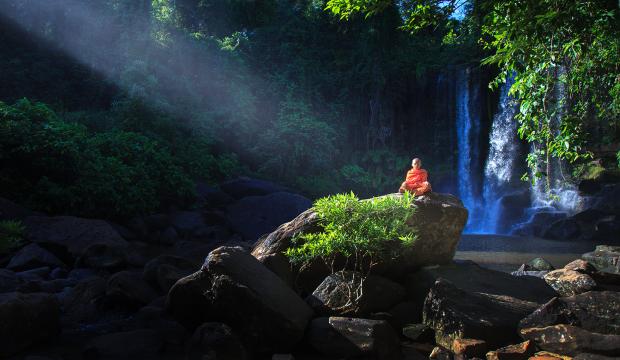
Kulen Mountain
The Kulen Mountain is declared as a National Park. It is about 48km from Siem Reap. Its highest point is 487 meters. This is widely regarded as the birthplace of the ancient Khmer Empire. During the constructional period of the ancient temples in the nineth century, sand stones were brought from this sacred mountain to Angkor. It was here at Phnom Kulen that King Jayavarman II proclaimed independence from Java in 802 A.D. The site is known for its carvings representing fertility and its waters hold special significance to the people of Cambodia. Just a few inches under the surface of the water, over 1000 carvings of Yoni and Linga are etched into the sandstone riverbed. The waters are regarded as holy, given the sacred carvings which also include a stone representation of the Hindu god Vishnu lying on his serpent.
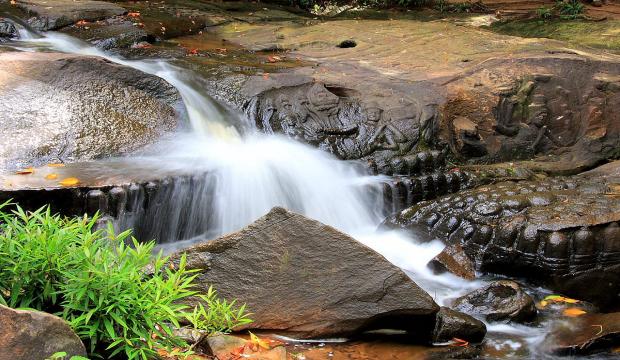
Kbal Spean Waterfalls & Temples
Kbal Spean is an Angkorian era archaeological site on the southwest slopes of the Kulen Hills to the northeast of Angkor in Siem Reap District, Siem Reap Province, Cambodia. Kbal Spean lies 50 kilometers northeast of Siem Reap pro-vincial town or about 18 kilometers from Banteay Srei on a dirt road. It takes from one to two hours to get there from the provincial town. The original River of Thousand Lingams, Kbal Spean is an intricately carved riverbed deep in the foothills of the Cam-bodian jungle. Lingams are phallic representations sacred to Brahmanism as symbols of fertility, and hundreds of them are carved into the rock here, as are several carvings of gods and animals above the small waterfall.
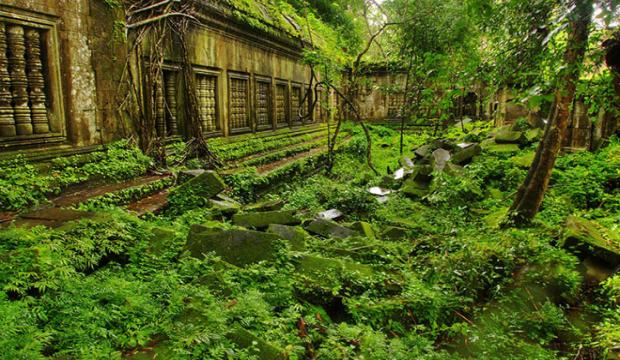
Beng Mealea Temple
Though unrestored, and in a fairly ruinous state, the large temple of Beng Mealea ('Lotus Pond') some 40 km due east of Angkor on the ancient royal way to the 'great Preah Khan' of Kompong Svay (another 60 km further on), is one of the major monuments of the classical period, in the style of Angkor Wat and roughly contemporary with it. Whoever built it must have been a figure of some importance, but he remains unknow, no inscriptions have been found here, and no other that mentions it. Its position was strategic, where the royal way to Koh Kerin the NE forks from the road E to the 'great Preah Khan', and also at the head of a canal that leads directly to the Great Lake, down which sandstone blocks from the nearby quarries could have been floated on their way to Angkor.

Preah Vihear Temple
Situated on the edge of a plateau that dominates the plain of Cambodia, the Temple of Preah Vihear is dedicated to Shiva. The Temple is composed of a series of sanctuaries linked by a system of pavements and staircases over an 800 metre long axis and dates back to the first half of the 11th century AD. Nevertheless, its complex history can be traced to the 9th century, when the hermitage was founded. This site is particularly well preserved, mainly due to its remote location. The site is exceptional for the quality of its architecture, which is adapted to the natural environment and the religious function of the temple, as well as for the exceptional quality of its carved stone ornamentation.
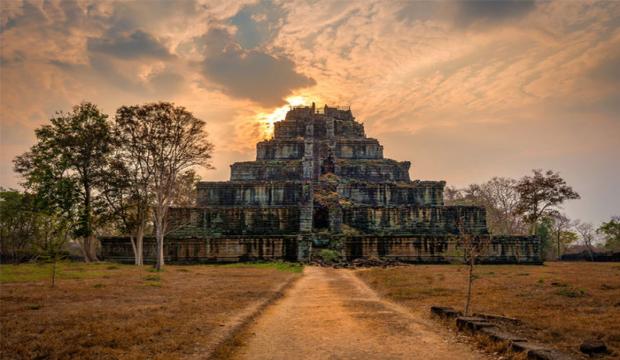
Koh Ker Temple
The foundations and donations during the reign of Koh-Ker-King Jayavarman IV include all the gods of the Brahmanic trinity, even Brahma, to whom no temples are dedicated in other Khmer towns. The preferred god of this king was Shiva, but this applies equally to his predecessors and successors in Angkor throughout the 10th and 11th centuries.The Devaraja symbol which was established at Prasat Thom was probably larger than any which preceded it and was placed on a higher pyramid. The king boasts of it in three inscriptions. Some deities or vocables were introduced at this time. The Devaraja was established at Prasat Thom in 921 under the vocable of Tribhuvaneshvara. The temple of Prasat Krachap was dedicated to Tribhuvanadeva in 928. The inscription of Prasat Kravan mentions the erection of the gods Tribhuvanesvami and Trailokyanatha near Angkor in 921, while the inscription of Chong Ang (Jen Ong), 922, mentions the erection of Tribhuvanakanatha.
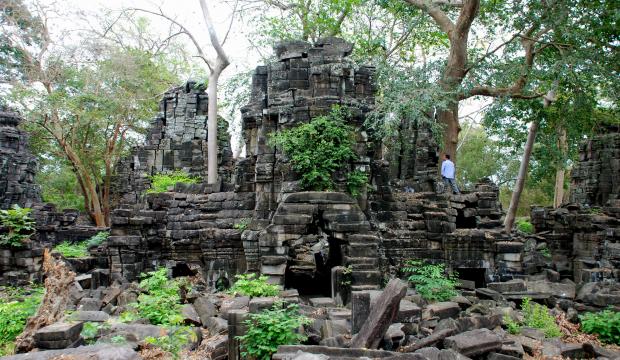
Banteay Chmmar Temple
This enormous complex, which was a temple city, is one of the most intriguing in the Khmer empire, both for it's scale and it's remote location. Never excavated, Banteay Chhmar fits the picture of a lost Khmer city with its ruined face-towers, carvings, forest surroundings and bird life flying through the temple. It has a romantic and discovery feel to it. Banteay Chhmar dates from the late 12th to the early 13thcentury and it means Narrow Fortress. It is thought to have been built by Jayarvarman II. It was later rebuilt by Jayarvarman VII as a funerary temple for his sons and four generals who had been killed in a battle repelling a Cham invasion in 1177.

Sambor Prei Kuk
The ancient city where monuments of Sambo Prei Kuk are found today was identified as ISANAPURA, the capital of Chenla in 7th century. Chenla was a former vassal of the Funan kingdom that was one of the first state in Southeast Asia, but it gradually gained its power and eventually King Citrasena Mahendravarman of Funan in the early 7th century. Main archaeological features in these groups of monuments are said to have been founded by king ISANAVARMAN I, the son of king Citrasena.
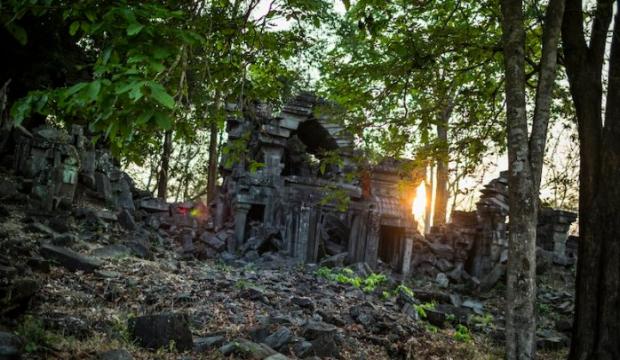
Bakan or Preah Khan Kampong Svay
The Bakan temples are located in Ta Siang village, Ronakse commune, Sangkum Thmei district, about 105 kilometers southwest of the provincial town. on a plain that was a former worship place of the king. The temple is surrounded by two ramparts-inside and outside rampart. Inside each rampart, there are many other temples such as Neang Peou and Dangkao Baodos temples.The temple was likely a royal palace and worship place. According to historians, the site used to be a hiding place of King Jayavarman VII before he ascended to the throne in AD 1181 because the style of some construction is similar to the style of Bayon and Ta Prohm temple.

Bakong Temple
The most impressive member of the Roluos Group, sitting at the center of the first Angkorian capital, Hariharalaya. Bakong stands 15 meters tall and is 650x850m at the outer wall. Constructed by the third Angkorian-era king as his state-temple, Bakong represents the first application of the temple-mountain architectural formula on a grand scale and set the architectural tone for the next 400 years. The temple displays a very early use of stone rather than brick. Though begun by Indravarman I, Bakong received additions and was expanded by later kings. The uppermost section and tower may have been added as late as the 12th century AD. Some of the lintel carvings, particularly on the outer towers, are in very good shape. Picturesque moat and vegetation surround Bakong.

Preah Ko Temple
Preah Ko was the first temple to be built in the ancient and now defunct city of Hariharalaya, some 15 kilometers south-east of the main group of temples at Angkor, Cambodia. Six towers displaying set on a platform, all beautifully preserved carvings. Originally surrounded by walls and gopuras of which only vestiges remain. Preah Ko was one of the first major temples of the empire at the early Khmer capital of Hariharalaya. Preah Ko (Sacred Bull) derives its name from the statues of bulls at the front of the central towers.
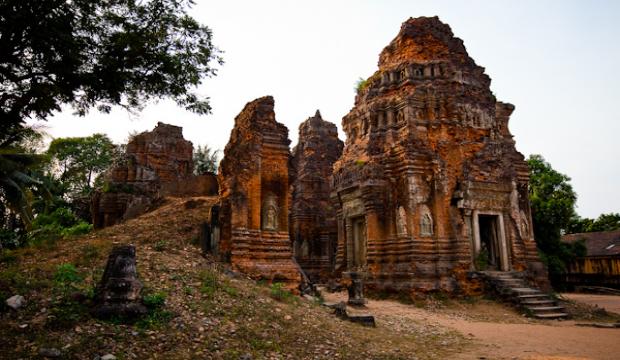
Lolei Temple
Ruins of an island-temple built in the middle of a now dry baray, Indratataka, the first large-scale baray constructed by a Khmer king. Lolei consists of four brick towers on a double laterite platform. It was the last major temple built at Roluos before Yasovarman I moved the capital to the Angkor area. Though the towers are in poor condition, there are some lintel carvings in very good condition displaying the distinctively detailed Preah Ko style. An active pagoda has been built amongst the ruins. Of the Roluos Group ruins, allocate the least time Lolei. See ‘Roluos Group’ and ‘Barays’.
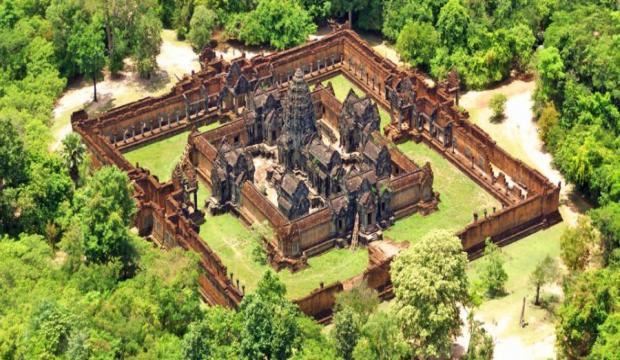
Banteay Samre Temple
Banteay Samre Temple is a bit off the Grand Circuit, near the southeast corner of the East Baray. The trip there is a nice little 3km road excursion through villages and paddies. Combine a visit to Banteay Srey with a stop at Banteay Samre on the way back. Large, comparatively flat temple displaying distinctively Angkor Wat-style architecture and artistry. The temple underwent extensive restoration this century by archaeologists using the anastylosis method. Banteay Samre was constructed around the same time as Angkor Wat. The style of the towers and balustrades bear strong resemblance to the towers of Angkor Wat and even more so to Khmer temple of Phimai in Thailand. Many of the carvings are in excellent condition.
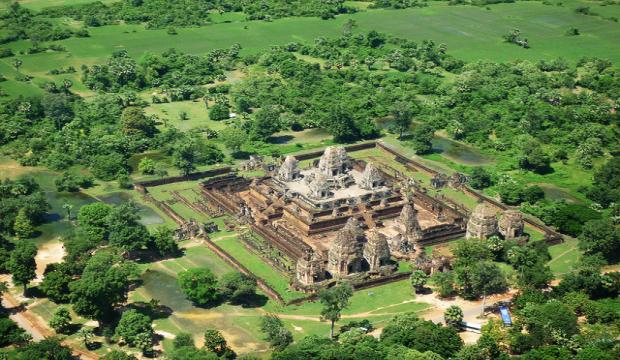
Pre Rup Temple
Architecturally and artistically superior temple-mountain. Beautifully carved false doors on upper level, as well as an excellent view of the surrounding countryside. Richly detailed, well-preserved carvings, particularly on the lintels. Traditionally believed to be a funerary temple, but in fact the state temple of Rajendravarman II. Historically important in that it was the second temple built after the Khmer capital was returned to Angkor after a period of political upheaval when the capital had been moved to Koh Ker. The artistically similar East Mebon was the first to be constructed after the return to Angkor, less than a decade earlier..
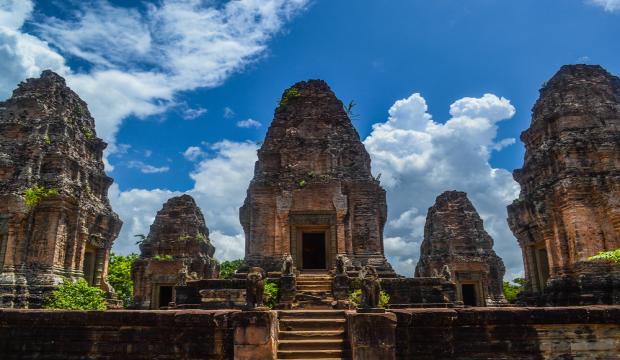
East Mebon Temple
East Mebon is a large temple-mountain-like ruin, rising three levels and crowned by five towers. Jayavarman IV, a usurper, moved the capital from Angkor to Koh Ker in 928AD. Sixteen years later Rajendravarman II returned the capital to Angkor and shortly thereafter constructed East Mebon on an island in the middle of the now dry Eastern Baray. The temple is dedicated to Shiva in honor of the king’s parents. Inscriptions indicate that it was also built to help reestablish the continuity of kingship at Angkor in light of the interruption that occurred when the seat of power had been moved to Koh Ker. There is some scholarly debate as to whether East Mebon should be categorized as a temple-mountain. Inscriptions record activity as early as 947AD, but the temple was not consecrated until 952AD.

Ta Som Temple
Small, classic Bayon-style monastic complex consisting of a relatively flat enclosure, face tower gopuras and cruciform interior sanctuaries much like a miniature version of Ta Prohm. Many of the carvings are in good condition and display particularly fine execution for late 12th century works. Take note of the devata carvings which show an uncommon individuality. A huge tree grows from the top of the eastern gopura. It is destroying the gate but it is a photo classic. Best photographed in the afternoon. Ta Som is the most distant temple on the Grand Circuit.


